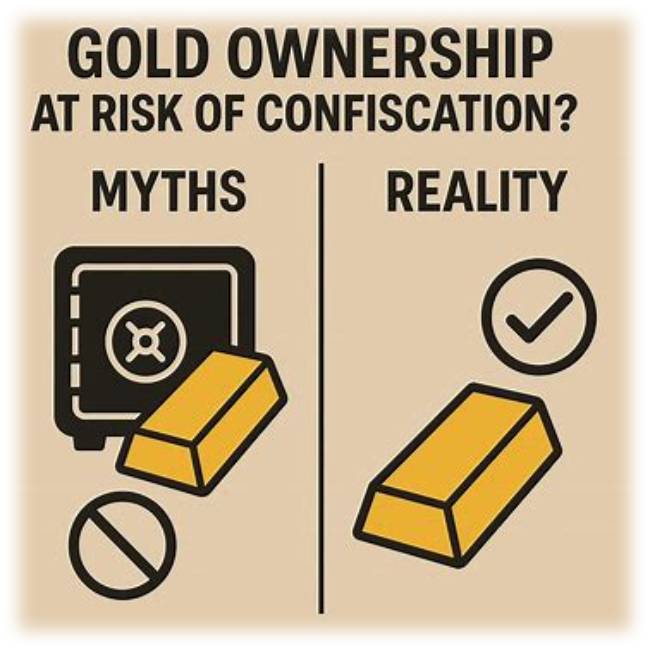Key Takeaways
- The 1933 U.S. gold confiscation was a unique historical event driven by economic crisis and the gold standard system, which no longer exists today, making similar confiscations highly unlikely.
- Modern governments do not have strong incentives to confiscate gold because fiat money, not gold, now backs the monetary system.
- Legal protections and regulations today safeguard private gold ownership, with confiscation facing significant legal, political, and economic barriers.
- Real risks to gold owners today include taxation on gains, inflation eroding purchasing power, and increased financial surveillance, rather than physical confiscation.
- Gold owners should focus on compliance with tax laws, proper documentation, and understanding economic factors rather than fear-based claims about confiscation.
Gold Ownership Risks: Confiscation Myths Versus Reality
Fears about government confiscation of gold have long haunted investors and savers alike. These concerns stem largely from historical incidents such as the notorious U.S. gold confiscation during the Great Depression.
To separate the facts of history from myths and understand the real risks associated with gold ownership today, this article aims to provide a factual exploration of gold confiscation history, the modern monetary context, and current risks facing gold owners.
Historical Context of Gold Confiscation
1933 U.S. Gold Confiscation Background
In 1933, President Franklin D. Roosevelt issued Executive Order 6102, requiring most Americans to surrender their privately held gold coins, bullion, and certificates to the Federal Reserve by May 1 of that year, in exchange for $20.67 per ounce.
The order was legally backed by the Trading with the Enemy Act of 1917, amended by the Emergency Banking Act of 1933, and noncompliance was punishable by fines up to $10,000 (equivalent to over $243,000 today), up to ten years imprisonment, or both. Exceptions allowed individuals to retain up to $100 in gold coins (about 5 ounces) and rare collectible coins recognized for their numismatic value.
This measure aimed to remove gold hoarding that was inhibiting economic recovery by limiting the Federal Reserve’s ability to expand the money supply under the gold standard.
Within a year, the Gold Reserve Act of 1934 revalued gold to $35 per ounce, effectively devaluing the dollar and allowing expansion of credit.
Approximately 20-25% of private gold was surrendered, with significant portions held back by some citizens. Private gold ownership remained restricted until 1974 when legislation under President Gerald Ford legalized private bullion ownership again.
Other Historical Episodes Worldwide
Similar episodes occurred in other countries amid economic or political crises.
Australia in 1959 authorized government seizure powers to protect currency; the UK restricted gold ownership in the 1960s; the Netherlands imposed tight controls during the Great Depression; and Nazi Germany systematically plundered gold from occupied territories.
These actions were context-specific, often during war or severe economic collapse, where governments prioritized national survival over private property rights.
Why History Fuels Modern Fears
The trauma of these confiscations, particularly the U.S. 1933 event with its harsh penalties and government control of gold, has left an enduring distrust. This history feeds conspiracy theories and marketing narratives promoting rare coins as confiscation-proof.
While these fears persist publicly, understanding the unique circumstances of those times is essential to assessing present-day risks.
The Modern Monetary System and Gold Ownership
End of the Gold Standard (Post-1971)
The monetary landscape has dramatically changed since the U.S. officially ended the gold standard in 1971.

Money today is fiat currency, created digitally by central banks through mechanisms like quantitative easing, interest rate policies, and open market operations. Physical gold no longer backs currency issuance, removing the system constraint that motivated past confiscations.
Current Distribution of Gold Ownership
Today, gold holdings are predominantly concentrated in central bank reserves and specialized institutional portfolios. Private ownership is relatively limited to a small percentage of households in the U.S. and other advanced economies.
Given this ownership pattern and the lack of systemic financial constraints tied to gold, the incentives for governments to confiscate gold have diminished significantly.
Legal Framework and Protections
Modern law generally protects private gold ownership, regulating rather than prohibiting it.
Requirements typically include taxation, precise record-keeping, and controls on import/export. Courts have supported property rights relating to gold, preventing arbitrary seizures.
While governments retain emergency powers in exceptional circumstances, outright confiscation faces substantial legal, political, and economic barriers today.
Real Risks to Gold Owners Today

Taxation Implications
Gold owners must comply with capital gains taxes when selling physical gold, treated by U.S. tax authorities as collectibles.
Reporting requirements enforce transparency, and failure to comply can result in significant penalties. Tax regimes vary globally but generally aim to capture revenue from gold as a financial asset.
Inflation and Wealth Erosion
Inflation effectively erodes purchasing power over time—a subtle but persistent risk that diminishes the real value of gold holdings if not accounted for correctly. Inflation is sometimes termed “confiscation by stealth,” as it reduces the real wealth of savers without direct government seizure.
Financial Surveillance and Regulatory Environment
The rise of digital payments, central bank digital currencies (CBDCs), and enhanced financial surveillance increases regulatory oversight of private transactions, including those involving gold.
Authorities can more easily track and tax gold-related financial flows, raising risks of increased compliance burdens and potential restrictions on storage and transfers.
Limitations and Challenges in Physical Gold Ownership
Physical gold faces practical risks, including theft, loss, and insurance limitations. Many owners opt for professional vaulting to obtain security, legal clarity, and insurance protection.
However, such storage can introduce counterparty or access risks that must be managed carefully.
The Debate on Gold Revaluation and Its Implications
What Is Gold Revaluation?
Gold revaluation is a government accounting practice that assigns a higher dollar value to existing official gold reserves. Several countries have used this tool to improve sovereign balance sheets without physically moving gold.
Potential Benefits and Risks
While revaluation can provide fiscal appearance relief by depicting improved asset values, it does not increase the physical quantity of gold or directly affect private ownership. It plays no role in debt repayment but can ease government liquidity perceptions.
Controversies and Speculations
Recent discussions speculate on U.S. gold revaluation linked to national debt management or bitcoin reserves. Any such move would be politically charged but unlikely to revive confiscation policies due to the adverse effects on investor trust and capital markets.
Separating Fact from Fiction: Addressing Common Myths

- The myth of imminent gold confiscation like in 1933 remains prevalent but ignores major systemic changes and legal protections.
- Rare coins are not immune to all risks but do offer exemptions historically recognized in confiscation orders.
- Claims linking rising premiums solely to confiscation fears often distort market realities.
- Confiscation today would be difficult, politically costly, and economically counterproductive compared to modern subtle forms of wealth control.
Practical Educational Takeaways (Non-Investment)
- Gold owners should understand their legal and tax obligations thoroughly to avoid compliance pitfalls.
- Meticulous documentation is essential for proving ownership and managing risks.
- Awareness of broader economic factors, including inflation and regulatory trends, is crucial for contextualizing gold’s value.
- Avoid reacting impulsively to fear-based claims; informed, measured understanding delivers better outcomes.
Conclusion
Historical gold confiscations, notably the 1933 U.S. event, represent unique crisis-driven government actions under vastly different monetary systems.
Today, the gold ownership landscape and legal frameworks have evolved, making such confiscations improbable in modern democracies.
While inflation, taxation, and financial surveillance pose real challenges, these indirect risks differ fundamentally from physical confiscations.
A fact-based comprehension of gold ownership risks helps individuals navigate this complex area with calm and clarity, grounded in historical lessons and current realities.
MEET THE RESEARCHER
Doug Young Financial Markets Researcher & Former Financial Director
- Over 20 years of experience in financial markets
- More than 15 years specializing in Gold IRAs
- Extensive expertise in precious metals trading
- Former Financial Director at World Freight Services Ltd for 16 years.
- Author of 500+ published financial research articles over 10 years
- Conducted 80+ Gold IRA company evaluations since 2011
⚠️ IMPORTANT: All content on this website is for educational purposes only and should not be considered personalized financial advice. Always consult with a qualified financial advisor before making investment decisions.













